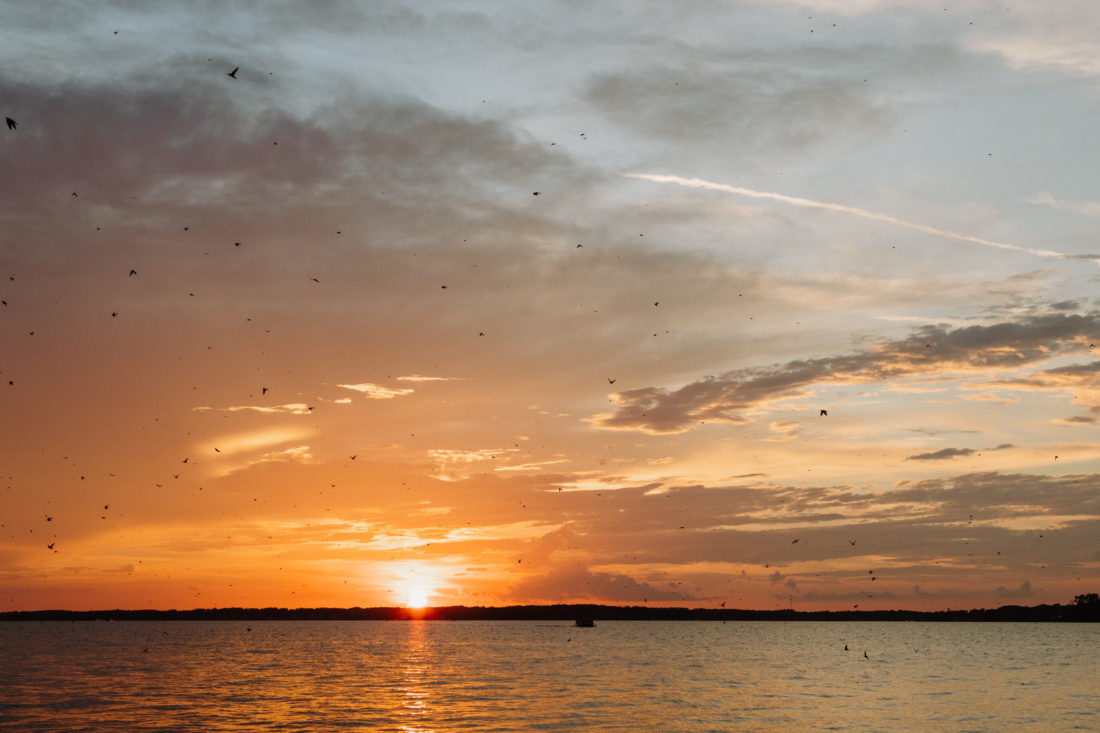We see just one bird at first, but soon there will be many, many more. From a pontoon boat on South Carolina’s Lake Murray, just outside Columbia, the naturalist Zach Steinhauser points out the purple martin’s flying pattern. “They’re the ones soaring around, more loosely knit rather than in a tight flock,” he says, “and they glide like a fighter jet.” An apt description, as we’re heading directly toward Bomb Island, a twelve-acre stand of trees surrounded by water.
Each spring, millions of purple martin birds, the largest swallow in North America, travel through the South during their migration from Canada to South America. Southerners hang gourd birdhouses for them to nest in and mark the changing of the seasons by their arrival. And come summer, approximately one million of these migrating birds make a pit stop to eat and rest at Bomb Island, their South Carolina cabana before heading even further south. Bomb Island, located right on the bird’s migration route, grows lush with shrubs and trees for perching, sits in water far away from predators, and since the 1980s, its regular visitors have been estimated as the largest martin roost on the continent.

“A bird that was tagged and recorded flying back and forth to Canada pinged just a few miles west of Lake Murray,” says Steinhauser, who leads boat tours here and has traveled to South America to study the birds. He keeps tabs on the migration with the Purple Martin Conservation Association’s tracking tools. Today, he’s our guide, along with captain Kenny Hardee. “It was right around roost time, so I speculate that bird went to Bomb Island for a spell. And then we know he crossed the Gulf and hung out in the Amazon rain forest in Brazil.”

Purple martins go to extraordinary lengths to find comfy landing spots year after year along the Atlantic Flyway. And by mid-September, they leave Lake Murray and continue on their journey. Steinhauser explains that there’s some evidence that Native Americans built nests for purple martins so the birds would live around their fields—early and efficient pest control. “You hear all the time in the news about how x, y, or z species are going extinct, but what we don’t often hear are the little things we can do to encourage and conserve wildlife,” Steinhauser says. “With martins, it’s as simple as putting some birdhouses out.”
He’s sharing all of this as we ride ever closer to Bomb Island. (The name comes from the land’s use as target practice during World War II air training.) Rain rolled through thirty minutes before, and thunderstorm clouds are leaving an orange-red sky in their wake.

A flock of black birds swoop together—common grackles, not purple martins, Steinhauser says. Other birds also love Bomb Island for its distance from predators. “Remember, look for the fighter jets,” he says. “It’s just a couple flaps and then they glide and cut through the air.”

And then they’re there, and there, and there and there! The sky fills with wings. Thousands and thousands of tiny dark planes, against a golden summer sunset, purple martins coming in for landing. We all fall silent. “When you’re engulfed in birds,” Steinhauser says later, “there’s something primal at work that you’ll never get over.”

Purple martins are roosting all over the South right now. To see them on Lake Murray and find more information about boat tours, click here.








